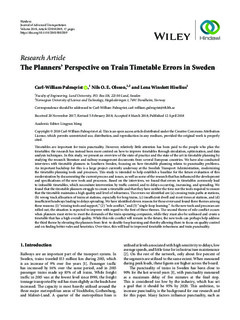| dc.contributor.author | Palmqvist, Carl-William | |
| dc.contributor.author | Olsson, Nils | |
| dc.contributor.author | Winslott Hiselius, Lena | |
| dc.date.accessioned | 2019-02-18T15:21:06Z | |
| dc.date.available | 2019-02-18T15:21:06Z | |
| dc.date.created | 2018-11-09T16:05:10Z | |
| dc.date.issued | 2018 | |
| dc.identifier.citation | Journal of Advanced Transportation. 2018, 2018 1-17. | nb_NO |
| dc.identifier.issn | 0197-6729 | |
| dc.identifier.uri | http://hdl.handle.net/11250/2586064 | |
| dc.description.abstract | Timetables are important for train punctuality. However, relatively little attention has been paid to the people who plan the timetables: the research has instead been more centred on how to improve timetables through simulation, optimisation, and data analysis techniques. In this study, we present an overview of the state of practice and the state of the art in timetable planning by studying the research literature and railway management documents from several European countries. We have also conducted interviews with timetable planners in Southern Sweden, focusing on how timetable planning relates to punctuality problems. An important backdrop for this is a large project currently underway at the Swedish Transport Administration, modernizing the timetable planning tools and processes. This study is intended to help establish a baseline for the future evaluation of this modernization by documenting the current process and issues, as well as some of the research that has influenced the development and specifications of the new tools and processes. Based on the interviews, we found that errors in timetables commonly lead to infeasible timetables, which necessitate intervention by traffic control, and to delays occurring, increasing, and spreading. We found that the timetable planners struggle to create a timetable and that they have neither the time nor the tools required to ensure that the timetable maintains a high quality and level of robustness. The errors we identified are (a) crossing train paths at stations, (b) wrong track allocation of trains at stations, especially for long trains, (c) insufficient dwell and meet times at stations, and (d) insufficient headways leading to delays spreading. We have identified eleven reasons for these errors and found three themes among these reasons: (1) “missing tools and support,” (2) “role conflict,” and (3) “single-loop learning.” As the new tools and processes are rolled out, the situation is expected to improve with regard to the first of these themes. The second theme of role conflict occurs when planners must strive to meet the demands of the train operating companies, while they must also be unbiased and create a timetable that has a high overall quality. While this role conflict will remain in the future, the new tools can perhaps help address the third theme by elevating the planners from first- to double-loop learning and thereby allowing them to focus on quality control and on finding better rules and heuristics. Over time, this will lead to improved timetable robustness and train punctuality. | nb_NO |
| dc.language.iso | eng | nb_NO |
| dc.publisher | Hindawi Publishing Corporation | nb_NO |
| dc.rights | Navngivelse 4.0 Internasjonal | * |
| dc.rights.uri | http://creativecommons.org/licenses/by/4.0/deed.no | * |
| dc.title | The Planners' Perspective on Train Timetable Errors in Sweden | nb_NO |
| dc.title.alternative | The Planners' Perspective on Train Timetable Errors in Sweden | nb_NO |
| dc.type | Journal article | nb_NO |
| dc.type | Peer reviewed | nb_NO |
| dc.description.version | publishedVersion | nb_NO |
| dc.source.pagenumber | 1-17 | nb_NO |
| dc.source.volume | 2018 | nb_NO |
| dc.source.journal | Journal of Advanced Transportation | nb_NO |
| dc.identifier.doi | 10.1155/2018/8502819 | |
| dc.identifier.cristin | 1628825 | |
| dc.description.localcode | © 2018 Carl-William Palmqvist et al. This is an open access article distributed under the Creative Commons Attribution License, which permits unrestricted use, distribution, and reproduction in any medium, provided the original work is properly cited. | nb_NO |
| cristin.unitcode | 194,64,92,0 | |
| cristin.unitname | Institutt for maskinteknikk og produksjon | |
| cristin.ispublished | true | |
| cristin.fulltext | preprint | |
| cristin.qualitycode | 1 | |

